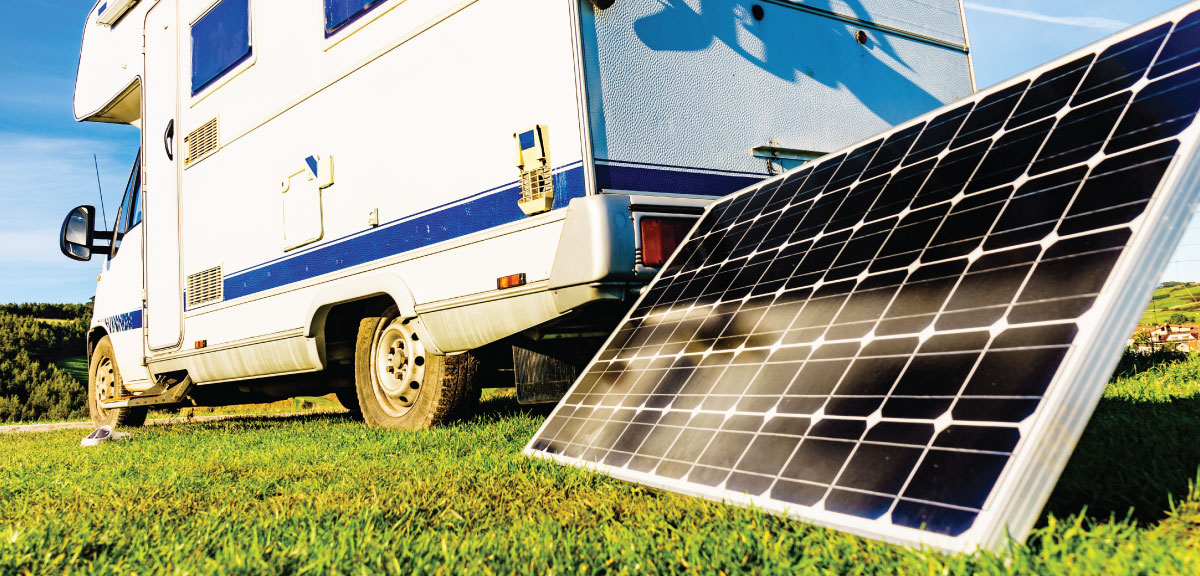Updated 3 months ago
The Best 100-watt Solar Panels: Guide to Usage and What You Can Run
Written by Ben Zientara Ben ZientaraBen Zientara is a writer, researcher, and solar policy analyst who has written about the residential solar industry, the electric grid, and state util...Learn more , Edited by Catherine Lane Catherine LaneCatherine has been researching and reporting on the solar industry for five years and is the Written Content Manager at SolarReviews. She leads a dyna...Learn more

Why you can trust SolarReviews
SolarReviews is the leading American website for solar panel reviews and solar panel installation companies. Our industry experts have a combined three decades of solar experience and maintain editorial independence for their reviews. No company can pay to alter the reviews or review scores shown on our site. Learn more about SolarReviews and how we make money.
Our experts perform independent testing and reviews of consumer solar products. If you buy through links on our site, we may get a commission.
SolarReviews is the leading American website for consumer reviews and ratings of residential solar panels and solar panel installation companies. We’re also a team of solar experts with decades of experience who want to educate people about all the ways that solar power can improve their lives.
When we review and recommend consumer products like portable solar panels and batteries, our opinions about these products are based on our own independent research and testing. While we sometimes receive free review samples and participate in brand affiliate programs, no company can pay for an endorsement, nor to alter or remove any of our reviews, and we maintain 100% editorial independence.
If you need a small-scale and affordable way to produce solar energy, the 100-watt solar panel might be exactly what you’re looking for. They come in multiple styles, from rigid to flexible to foldable, and usually cost between $70 and $200 per panel.
100-watt solar panels are a little too small to be effective at running your whole home, but you can use them for virtually any off-grid project. They’re an affordable and versatile way to begin making your own power.
Our picks for the best 100-watt panels on the market today are:
Best rigid: Renogy RNG-100D-SS
Best flexible: BougeRV Arch 100
Best portable: BougeRV ISE192
Best affordable: JJN 100W 9BB
Best all-black: EcoFlow 100W Rigid Panel
100-watt solar panels at a glance
Prices for 100-watt solar panels range from about $70 to $200, with the higher-priced panels coming with long warranties and premium features.
A 100-watt solar panel typically produces between 300 and 600 watt-hours (Wh) of solar energy per day.
A 100 W panel provides enough power to run or charge a few small electronic devices, like WiFi routers and cell phone chargers.
The best 100-watt solar panels in 2024
Since many types of 100-watt solar panels exist, we decided to break our expert recommendations into categories. Here is our list of the best choices for 100-watt solar panels on the market:
Category | Brand and model | Notes | Cost |
|---|---|---|---|
Best rigid panel | Renogy RNG-100D-SS | White backsheet, aluminum frame, rigid plastic corner supports, 10-year warranty | |
Best flexible panel | BougeRV Arch 100 | All black, lightweight fiberglass construction, 10-year warranty | |
Best portable panel | BougeRV ISE192 | Foldable, metal grommets for mounting, 10-year warranty | |
Best affordable panel | JJN 100W 9BB | Ultra-affordable but with features like the best brands, 18-month warranty | |
Best all-black panel | EcoFlow 100W Rigid Panel | Premium all-black design, IP68 waterproof, 5-year warranty |
Here is some more info about each of our top picks:
Best rigid 100- watt panel: Renogy RNG-100D-SS Rigid Solar Panel
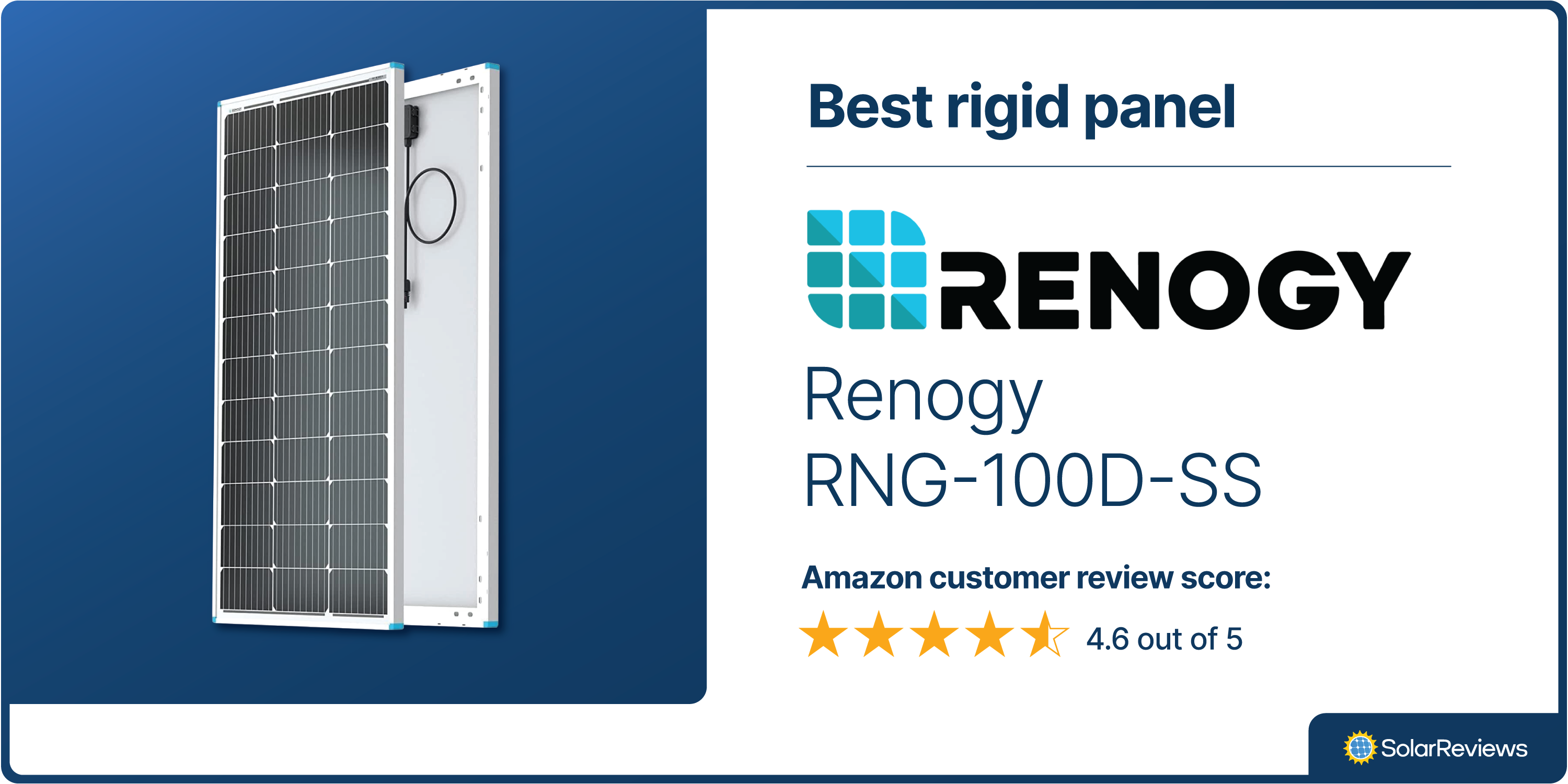
Pros
Comes from a well-known name
Excellent construction, with sturdy plastic protective corners
10 year warranty
Cons
Slightly more expensive than the cheapest options
Uses a white backsheet and aluminum frame, so it’s not all black
If you’re looking for a great, affordable option from a well-known company, the Renogy 100-watt rigid solar panel is an excellent choice. With its quality construction and thoughtful touches like the protective plastic corners on the frame, this panel sets the standard for all others on our list.
Perhaps most important is that this monocrystalline solar panel comes from Renogy, a well-known brand in the industry that has been in business for years with lots of satisfied customers.
A final note about this panel is that it has a white backsheet, meaning you can see the spaces around the cells. In one sense, this is good because it makes the panel more efficient and less prone to heat-related power loss. On the other hand, some people prefer the all-black look of a panel like the EcoFlow all-black panel (details below).
Key Features
36 PERC solar cells with 9 busbars (the wires that gather electricity from the cell surface)
White backsheet
Sturdy aluminum frame with durable plastic corners
10-year warranty from a well-known company
Best flexible 100-watt panel: BougeRV Arch 100 Flexible Solar Panel
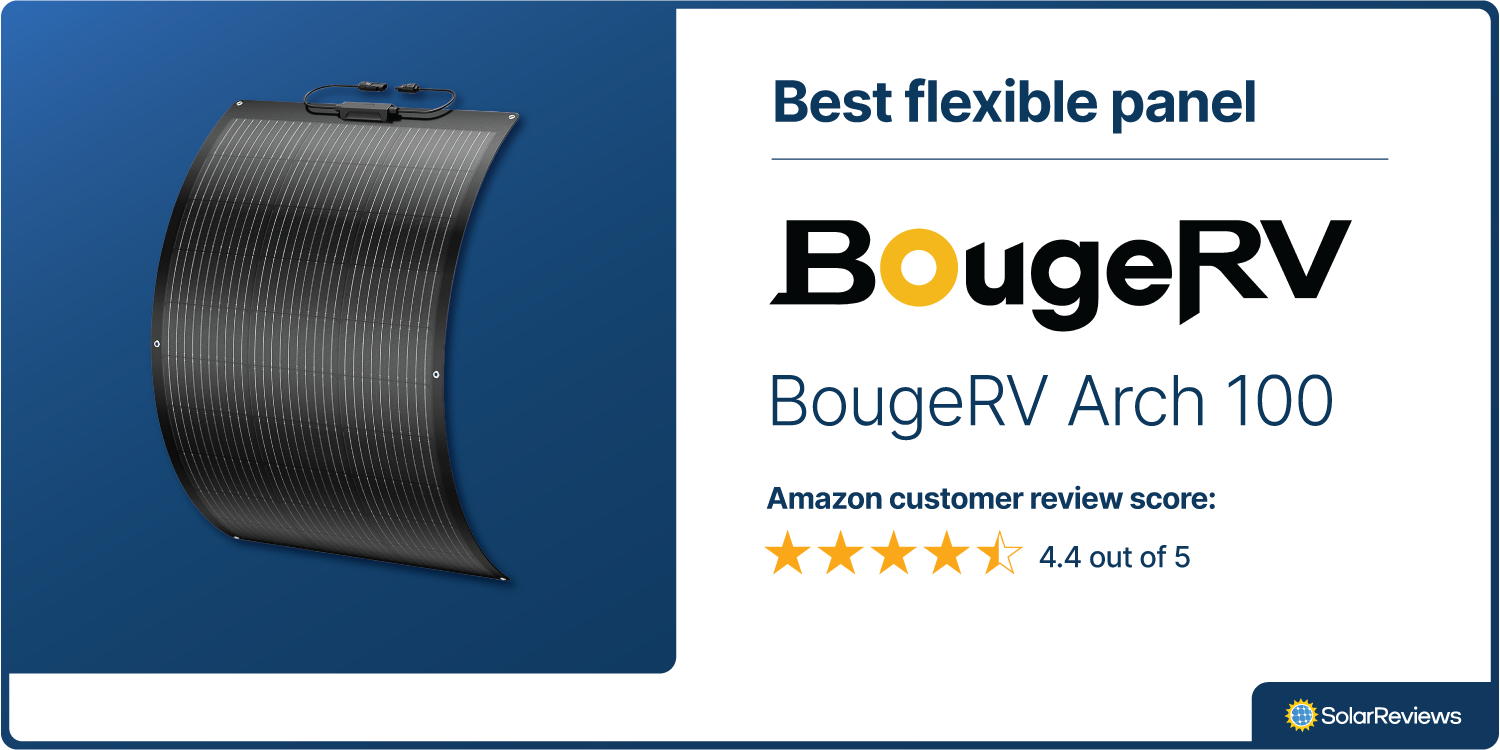
Pros
Very durable despite being thin and lightweight
Flexibility means it can be applied to curved vehicle roofs
Excellent warranty from a well-known brand
Cons
Somewhat expensive compared to popular rigid options
Somewhat less efficient when applied to a surface because it traps heat
The durable, flexible, and lightweight BougeRV Arch solar panel is an excellent choice for people who want an ultralight solar panel for mounting on their vehicle roof. The Arch is made with fiberglass and very thin monocrystalline solar cells, making it perfect for mounting on curved surfaces like an RV or camper roof.
The benefits of this style of panel are its ultra low profile and versatility. The panel can be mounted by using the built-in metal grommets or attached to a roof using double-sided tape. That said, this panel isn’t as efficient as some rigid options, simply because those allow for more airflow under the panel, and solar cells perform worse as they get hot.
This panel isn’t as robust as the 200-watt BougeRV Yuma flexible thin-film solar panel, but it comes at a lower price and can still meet your energy needs.
Key Features
30 PERC solar cells with 10 busbars
Black backsheet
Flexible fiberglass construction
10-year warranty from a well-known company
Best portable 100-watt panel: BougeRV ISE192 Portable Solar Panel
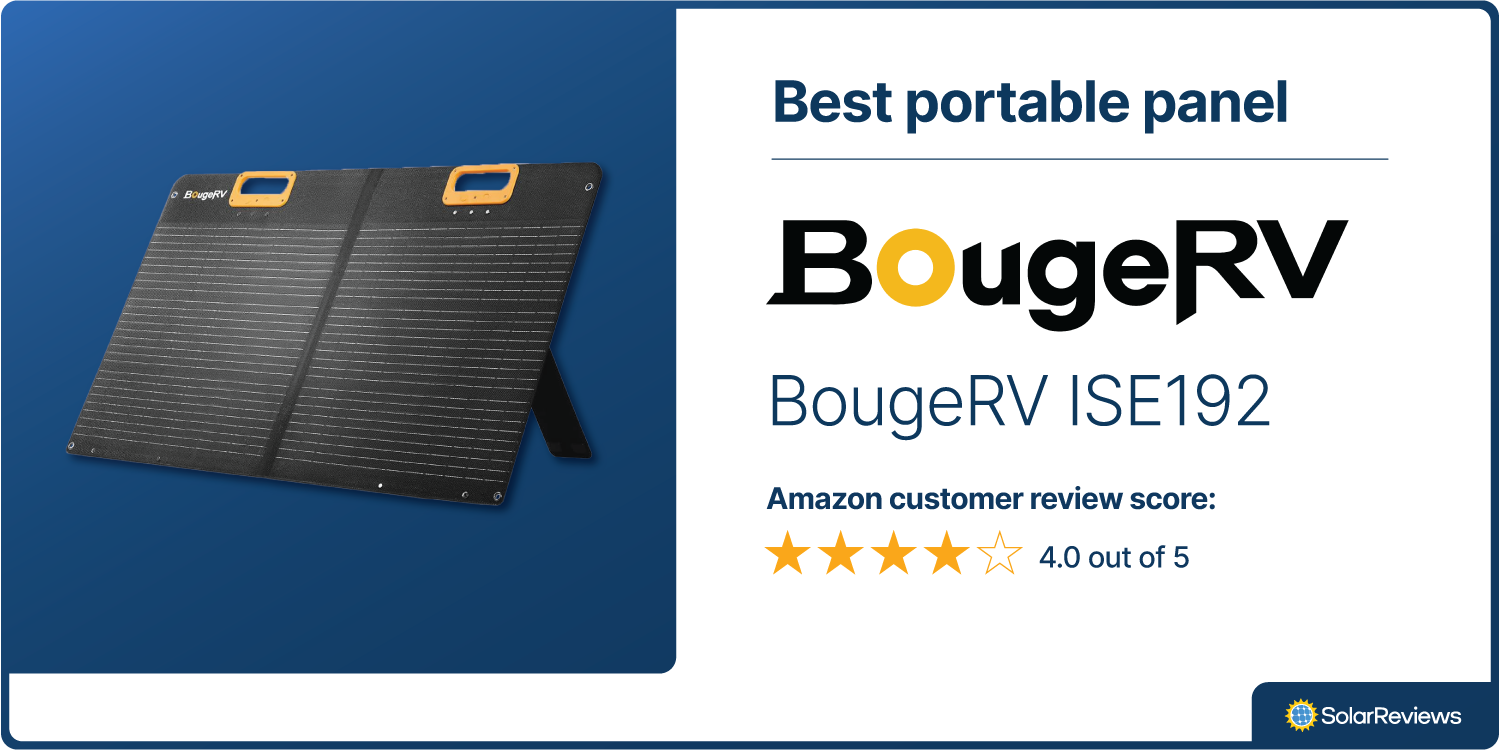
Pros
Foldable and portable at 10 lbs
IP67 waterproof
10-year warranty is unmatched in the portable solar panel world
Cons
More expensive than some other options
Fewer features than some options
The BougeRV ISE192 portable solar panel wins our "best portable" award for its mix of quality, portability, and especially its warranty. There are cheaper foldable panels on the market, but they can't come close to BougeRV's 10-year warranty. Similarly, there are fancier foldable panels with USB outputs, like the Jackery SolarSaga 100, but they're too expensive and don't have as good of a warranty.
When it comes to foldable panels, you'll use and abuse them, tossing them in the back of a car full of camping supplies and leaving them out in the elements while you're in the wilderness. You'll grab and unclasp their Velcro closures and flip out their kickstands hundreds of times.
In all honesty, you should probably expect a portable panel to fail within a few years, which is why the warranty coverage on this product is such a great thing. And it comes from a company that has been around longer than most and can back that warranty up.
Key Features
18 PERC solar cells with 9 busbars
IP67 waterproof
Black backsheet
Foldable ETFE/EVA plastic and water-resistant fiber cloth construction
10-year warranty from a well-known company
Best affordable 100-watt panel: JJN 100-watt Monocrystalline Solar Panel
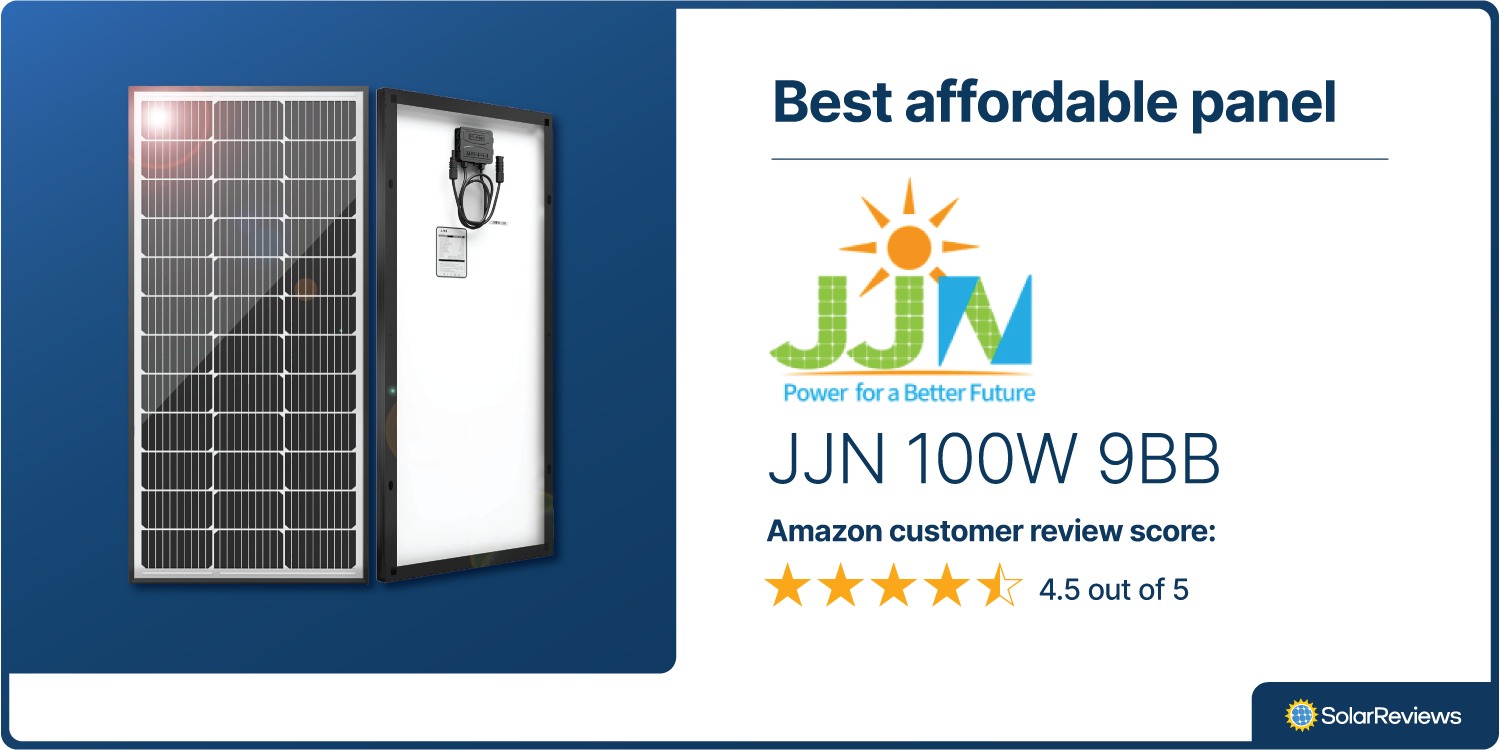
Pros
Very low cost
The same specs as more expensive options
Cons
Not as well known as other companies
18th month warranty is on the shorter side
If you’re looking for the absolute cheapest brand-new 100-watt solar panel on the web, the JJN 100-watt panel is definitely on the shortlist. This panel sells at Amazon for just $69.99, about $20 less than the regular price of the Renogy panel higher on this list. The JJN panel frequently battles with the Eco-Worthy 100-watt solar panel (4.4 stars, 12-month warranty) for the title of Amazon’s cheapest.
Of course, JJN isn’t as well-known a brand as Renogy, meaning you might worry that its 18-month warranty isn’t good enough. You wouldn’t necessarily be wrong to worry, but as long as you’re using a solar module every day in the sun, you should be able to tell fairly quickly if it will exhibit signs of an issue that will be covered by warranty.
So if you’re ready to get a solar panel out in the elements and you’re looking for the lowest price, period, JJN is your pick.
Key Features
36 PERC solar cells with 9 busbars
White backsheet
Rigid glass/EVA construction with black aluminum frame
18-month warranty
Best all-black 100-watt panel: EcoFlow 100W Rigid Solar Panel
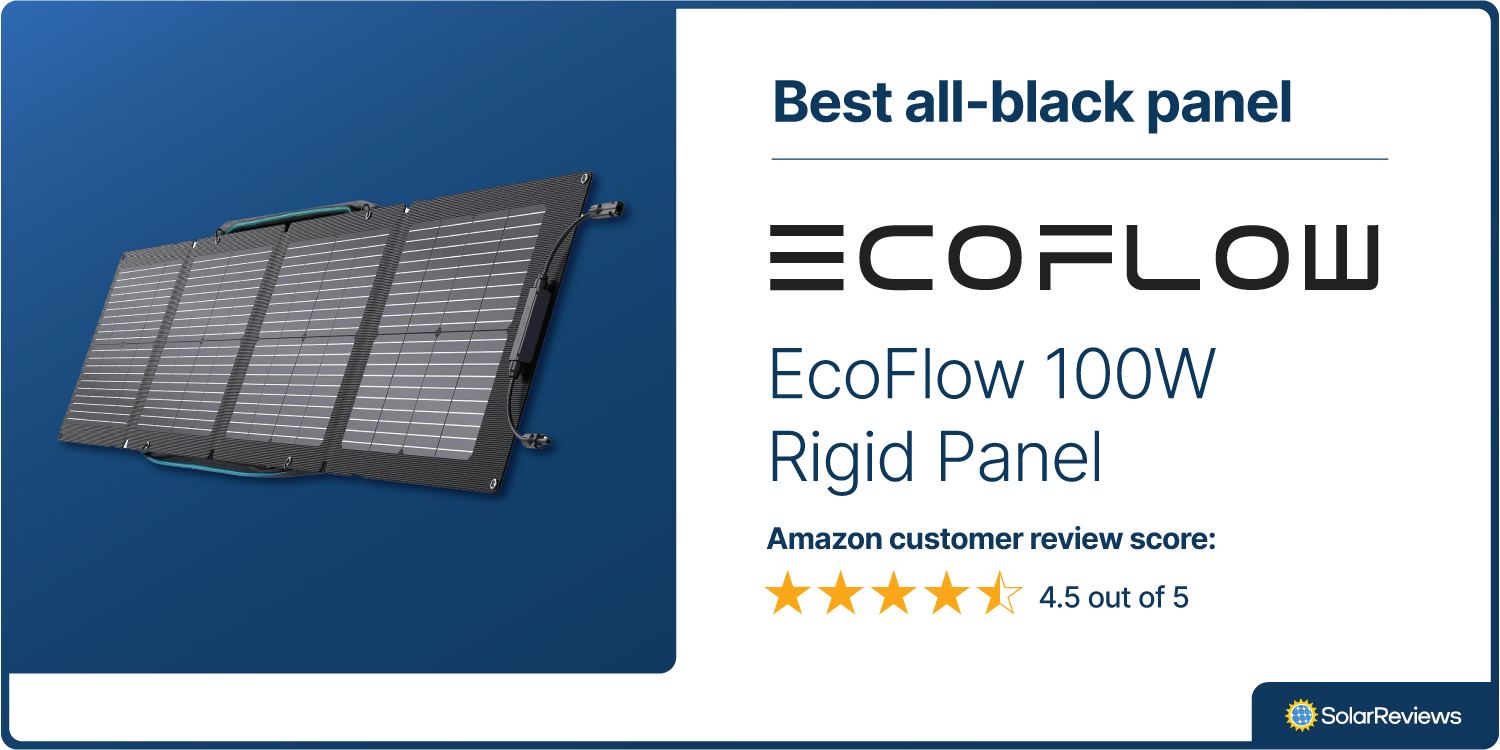
Pros
Sleek all-black look to impress your friends
IP68 waterproof
5-year warranty from a really well-known company
Cons
More expensive than other options
All-black panels are slightly less efficient
Can only buy in a pair from Amazon
If you love the all-black look and want a small solar panel that fits your aesthetic, check out the EcoFlow 100W all-black panel. This premium product looks fantastic and offers the best waterproofing in our lineup at IP68.
As a bonus, this panel comes with a 5-year warranty, and EcoFlow is a leading company in the DIY off-grid solar space, so you can feel confident that the company will support you in the future.
Key Features
30 PERC solar cells with 10 busbars
Black backsheet
Rigid glass/EVA construction with black aluminum frame
5-year warranty from a well-known company
How much do 100-watt solar panels cost?
100-watt solar panels cost between $70 to $200, depending on the type of solar panel and the brand.
The price differences are mainly due to warranty support and portability. Choosing a panel from a well-known brand with a long warranty will cost more than a no-name product without much (if any) manufacturer support.
Rigid solar panels made with glass and aluminum tend to be less expensive because they’re simpler, but they’re not easy to carry with you. Ultra-lightweight and foldable portable panels are easy to carry but they're made with more high-tech lightweight materials like fiberglass, EVA plastic, and ripstop fabric. They’re more complicated and, therefore, more expensive.
How much power does a 100-watt solar panel produce in a day?
In terms of instantaneous output, a 100 W panel may be able to hit its maximum power output of 100 watts of DC power when it’s very sunny, but the rest of the time, the output will likely be lower than that.
It is more useful to measure solar panel output over time using watt-hours (Wh). A 100-watt solar panel typically generates between 300 and 600 Wh per day.
Location and weather determine output
The average output of a 100-watt solar panel differs from place to place due to varying latitude and climate conditions.
Panels can generate the most energy in locations that receive lots of direct sunlight. In Arizona, for instance, you’ll consistently see excellent power output – an average of 750 Wh per day.
At the other end of the spectrum, there’s Alaska. There, the long months of winter darkness mean average output drops to just 280 Wh a day.
As you’d expect, the average output you’ll see in all other states will fall somewhere between these two extremes. Here’s a map that indicates the average daily power output of a 100 W solar panel in each state:
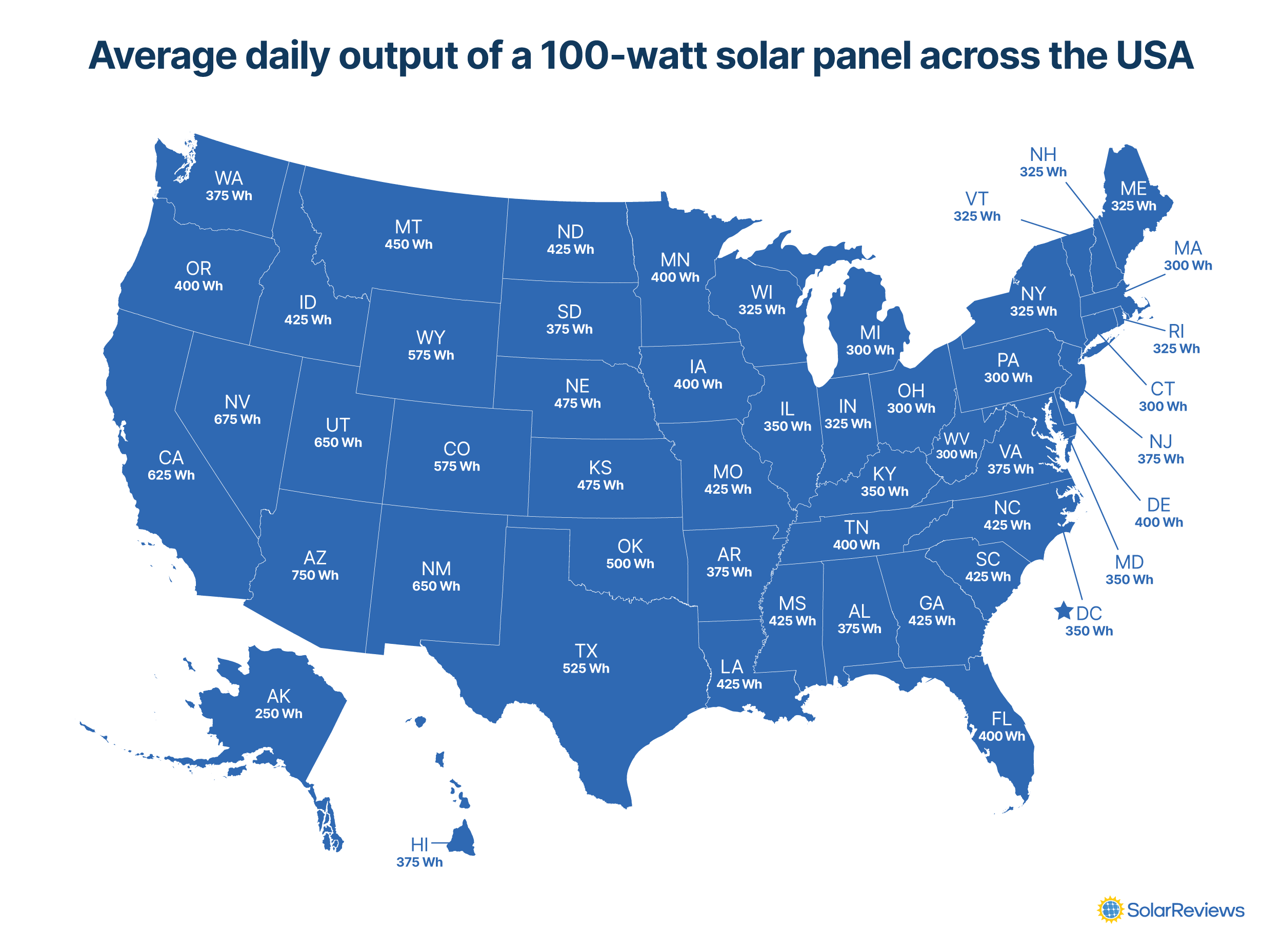
What can a 100 W solar panel run?
A 100-watt solar panel can power multiple small devices like smartphone chargers, LED lights, and even a TV and video game system for over five hours when paired with a solar generator.
This table outlines how long you can expect to run different devices with a 100 W solar panel and solar generator:
Device(s) | Typical power usage | Run time |
|---|---|---|
Four smartphone chargers | 80 W | 6.25 hours |
Macbook charger | 67 W | 7.5 hours |
32” LED TV and Nintendo Switch | 50 W | 10 hours |
Cable modem and router | 40 W | 12.5 hours |
Two LED light bulbs | 20 W | 24 hours |
*Assumes 500-watt hours of usable energy
Let’s take a moment to appreciate just how awesome modern electronics are. We can now run an entire video game console and TV with less wattage than we used to use for one incandescent light bulb.
Of course, if you want to run all the devices listed above, you would only be able to do it for a couple of hours before the battery is fully drained. If you need more energy every day, consider expanding your system’s capacity with additional panels, or even doubling up to 200-watt solar panels (maybe even more than one).
How do you use a 100 W panel?
The best use for 100-watt solar panels is to provide a little bit of energy for small jobs. These aren’t the kind of panels you’d want to use on your house (check out 400-watt solar panels for that), but they can be great for a greenhouse, a tool shed, or off-grid applications.
Using a solar panel isn’t as easy as putting it in the sun and plugging things into it. There are two main reasons for that:
Power output varies widely by how much sunlight is shining
A solar panel outputs DC power, while most appliances and devices use AC power
To be sure you have enough power to run things, you’ll want to store it in some batteries before using it. Also, the DC power must be converted to AC before you can use it to run things with standard plugs.
To do that, you need a few things: a battery, an MPPT solar charge controller to manage the battery, and an inverter to switch the DC power into AC power. Luckily, there is a simple way to get all the necessary components: a solar generator (aka portable power station) like these:
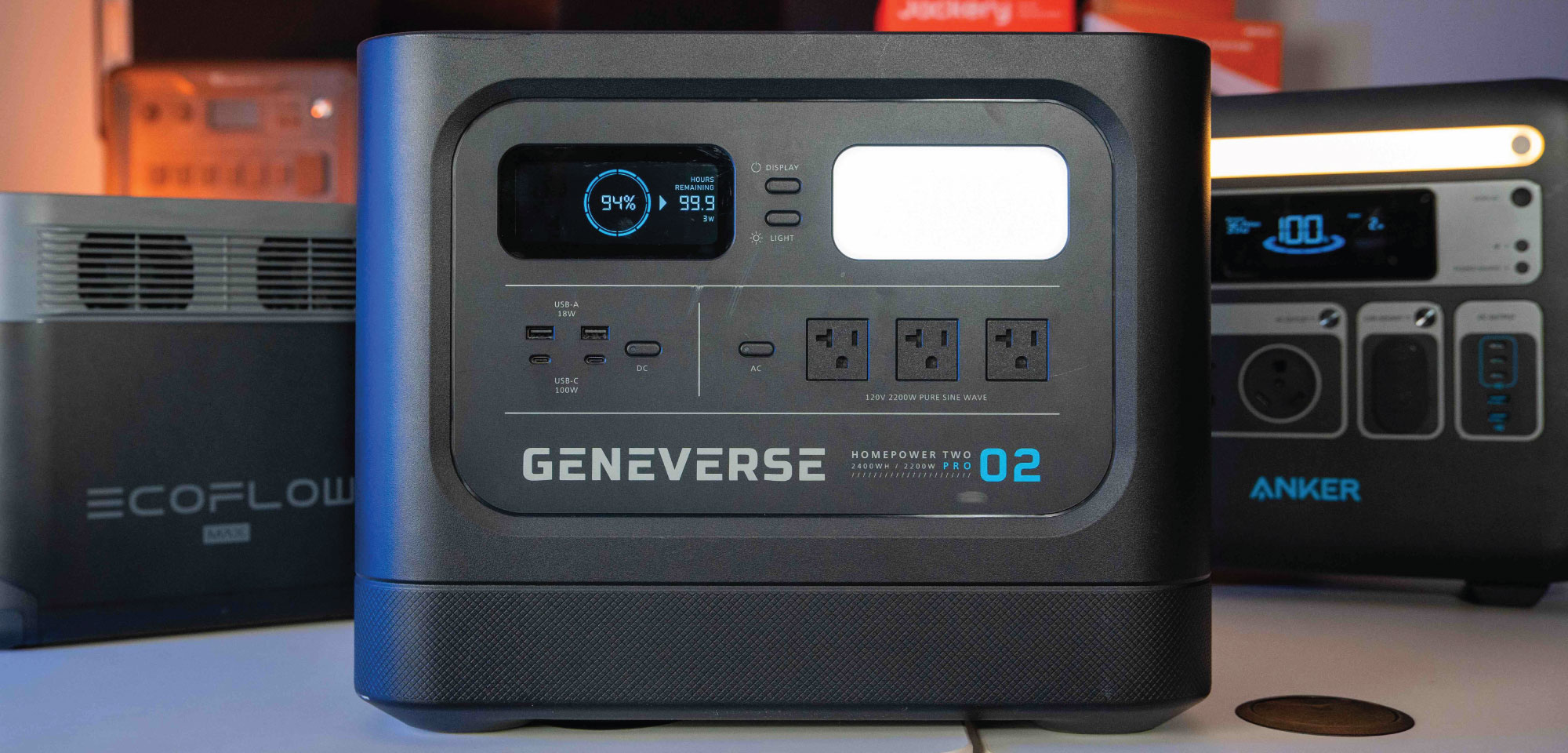
These amazing inventions pair a small amount of energy storage (i.e., a battery) with a charge controller and inverter and also include multiple ways to charge the battery (solar, wall power, or a vehicle adapter).
All of the 100-watt solar panels listed above can work to charge a portable solar generator, but there are a couple of important things to know first: the open circuit voltage (VOC) of the solar panel and the input port of the solar generator.
Open circuit voltage (VOC)
The “open circuit voltage” (VOC) of the solar panel refers to the amount of volts the panel produces when it is not plugged in. If the voltage is too high for the charge controller, the solar generator can be damaged.
Most 100-watt solar panels have a VOC between 20 and 25. Make sure to choose a solar generator with a minimum input voltage below the panel’s VOC and a maximum input voltage higher than the VOC. You want the panel to be able to charge the batteries but not overload the charge controller in the generator.
Different kinds of input ports
Most solar generators these days have an XT60 port, but other kinds include Anderson ports and DC input jacks. EcoFlow solar generators often use a special input port called XT60i, which includes an extra contact between the two main ones to tell the generator to charge at a higher rate if it can.
Nearly all of the 100-watt solar panels on the market will come with MC4 solar connectors, a universal standard in the solar industry. Just make sure you know which input your solar generator has and that you have a cable that can connect between the MC4 connectors and the generator's input.
Bottom line on 100-watt solar panels
The truth is this: 100-watt solar panels are very much an “entry-level” product for small-scale applications. Even under full sun for an ordinary summer day, they won’t generate a ton of usable electricity. That said, if you need a super portable solar panel that is easy to use for charging a small portable solar power station, you can’t go wrong with a 100-watt panel. And if you need more power, you can always increase the quantity to create a solar array.
As we’ve shown above, several kinds of 100-watt solar panels are available, from simple, rigid panels made with silicon cells between glass and EVA plastic surrounded by an aluminum frame to portable, foldable panels with high-tech fabric covers and kickstands. These options let you choose the right 100-watt solar panel for your small job, whether it’s in the outback or just the backyard.
100-watt solar panels frequently asked questions (FAQ)
Can you connect multiple 100 W panels together?
Yes, you can connect panels in series, parallel, or series parallel to produce more wattage, as long as the device you’re connecting them to can handle the input.
Do I need a battery with my 100 W panel?
Some 100-watt solar panels come with USB ports on the back to help you power devices directly, but for most uses, you’ll want a solar charge controller, battery, and inverter to store and use the solar energy you generate. Or, choose a solar generator that combines all those devices in one handy box!
Can you power a home with 100 W solar panels?
It is generally not a good idea to use a 100-watt solar panel to power a home, because the surface area of the panel is not large enough to produce enough voltage for a large sized inverter. It is better to choose 400-watt solar panels, and design a solar array that can meet your needs.
Should you get a 100-watt bifacial solar panel?
Probably not. Bifacial solar panels can make a little extra electricity by collecting reflected light when they are installed over a brightly-colored surface, but because 100-watt solar panels are relatively small, the extra materials to make them bifacial aren’t cost effective. That said, some companies now make larger bifacial portable solar panels.
Ben Zientara is a writer, researcher, and solar policy analyst who has written about the residential solar industry, the electric grid, and state utility policy since 2013. His early work included leading the team that produced the annual State Solar Power Rankings Report for the Solar Power Rocks website from 2015 to 2020. The rankings were utilized and referenced by a diverse mix of policymakers, advocacy groups, and media including The Center...
Learn more about Ben Zientara